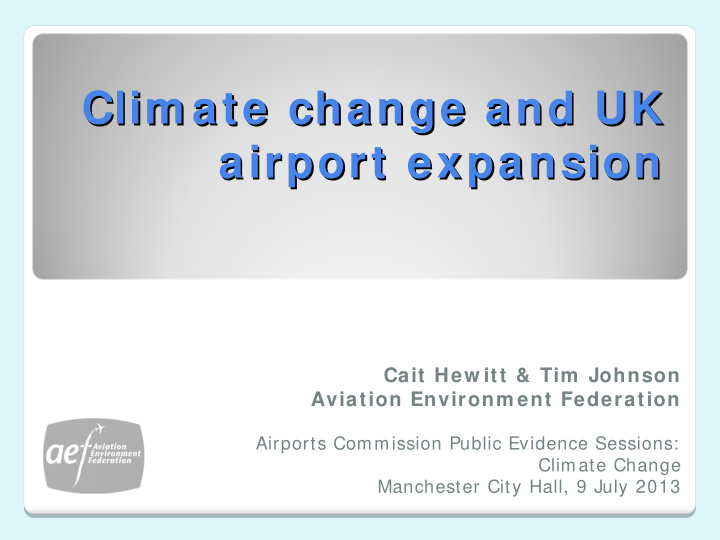



Clim ate change and UK Clim ate change and UK airport expansion airport expansion Cait Hew itt & Tim Johnson Aviation Environm ent Federation Airports Commission Public Evidence Sessions: Climate Change Manchester City Hall, 9 July 2013
The AEF ... The AEF is the principal environmental association in the United Kingdom concerned specifically with all the environmental and amenity effects of aviation. Established in 1975, AEF’s membership comprises over 100 organisations representing communities living around the UK’s airports and airfields, and environmental organisations. The AEF provides an environmental voice at the DfT’s External Advisory Group and recently provided the sole NGO representation on the South East Airports Taskforce (SEAT). AEF is a co ‐ founding member of the International Coalition for Sustainable Aviation (ICSA) which provides environmental NGO’s with observer access to the UN’s International Civil Aviation Organisation, actively participating in the negotiations on climate change since 1998.
Aviation emissions in the UK Historically, the UK is second only to the US in terms of cumulative emissions from international aviation between 1974 ‐ 2009 (8.29% of total). UK aviations emissions are effectively included in the UK target to cut emissions by 80% below 1990 levels by 2050 as established by the Climate Change Act. The Committee on Climate Change has recommended that this target could be met with an 85% reduction across all other sectors of the economy if aviation emissions are kept at 2005 levels in 2050 (equivalent to 37.5MtCO 2 ). To achieve this goal in the aviation sector, the CCC analysed that technological and operational improvements, plus alternative fuels, would still require growth to be limited to around 365 mppa (a 60% increase by 2050 compared with 2005). In contrast the DfT’s central 2050 constrained passenger forecast (i.e. no new runways) estimates 445 mppa, a 93% increase over 2005 levels. No new runways are required to meet demand levels consistent with delivering UK climate goals, and; an analysis conducted by AEF for WWF demonstrates that existing runway capacity already exists in each region even in the South East.
Will additional industry effort affect this analysis?
Will additional industry effort affect this analysis?
“Potential” versus “likely” scenarios: closing this emissions gap will require significant government and industry action Source: MMU, 2013 Total emission reduction effort to meet 2020 goal in 2050 is 1017Mt. Emission gap in 2050 is between 153Mt and 387Mt (15-38% of total effort).
International action? • AEF supports international action and is actively backing aviation’s inclusion in the EU ETS, and an international agreement at ICAO • However, the future of EU ETS is uncertain and it is likely that the original geographical scope will be reduced, perhaps significantly, after “Stop the Clock” • Despite NGO and industry calls for agreement on a market ‐ based measure this year, the likely outcome is ongoing work leading to the next ICAO assembly in 2016 • Even with a successful agreement, DfT modelling already assumes carbon pricing.
Conclusion • Irrespective of an international strategy, there will be, over the longer ‐ term, an increasing focus on in ‐ sector reductions (as economy wide reductions will leave little room for offsetting emissions). • Given the realistic projections of in ‐ sector gains though tech/ops/alt fuels over this period, the need for demand constraint in the UK remains in order to achieve climate objectives. • If the Commission keeps its focus on the longer ‐ term, the provision of new runways cannot be justified and would result in failure to meet our legal commitments under the Climate Act.
Recommend
More recommend